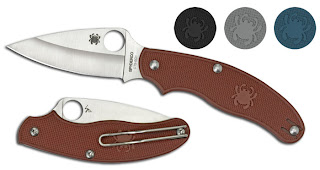In the late 1800s, James Carpenter received a patent for a tool steel that was air-hardened. At that point in history, James Carpenter's industrial complex amounted to just one building in Pennsylvania. This was the beginning of what would be known today as Carpenter Technology Corporation, a producer of a wide array of steels along with other metallurgical products.
Carpenter Technology Corporation produces a wide array of products that surround us in our day to day lives. In the car you drive, the plane you fly, from the doctor's office to outer space, chances are you have encountered their products without even knowing about it. Unlike the cars and planes that are branded with the manufacturers name and logo, Carpenter and other industry suppliers don't often get the opportunity to brand their products, at least not in a fashion that would be recognizable to most of us. The premium knife industry understands that the type of steel used to make the blade of the knife is very important to the end user (you and me). With this in mind, knife manufacturers have been labeling the blades of their knives with the type of steel used to produce it. This bit of information helps those of us that have a steel fixation (also known as "Steel Junkies") to better choose the knife that is most appropriate for the task at hand.
CTS™ XHP
- Offers grindability, edge retention and corrosion resistance comparable to 440C stainless steel.
- Contains 1.60% Carbon, 0.40% Silicon, 0.35% Nickel, 0.45% Vanadium, 0.50% Manganese, 16.00% Chromium, 0.80% Molybdenum.
- Ideal hardness (HRc) is between 60 - 64.
- Can be compared to a corrosion resistant D2 tool steel or a high hardness (HRc) 440C stainless steel.
- Can be polished or left in a matte finish.
 |
| Spyderco Military, Plain 4" CTS-XHP Blade, Brown G-10 Handle Sprint Run C36GPBNXHP |
- Offers high hardness and wear resistance
- Contains 0.85% - 0.95% Carbon, 0.040% Phosphorous, 1.00% Silicon, 0.50% Molybdenum, 1.00% Manganese, 0.030% Sulfur, 15.00% - 17.00% Chromium.
- Ideal hardness (HRc) is between 58 - 60.
 |
| Spyderco UK Penknife, CTS-BD1 Stainless Steel Blade, FRN Handle C94FRN |
- Offers high wear resistance and high corrosion resistance.
- Contains 1.90% Carbon, 0.60% Silicon, 1.00% Molybdenum, 0.65% Tungsten, 0.35% Manganese, 20.00% Chromium, 4.00% Vanadium.
- Ideal hardness (HRc) is between 57 - 63.
- Offers high hardness.
- Contains 0.95% - 1.20% Carbon, 0.040% Phosphorous, 1.00% Silicon, 0.75% Molybdenum, 1.00% Manganese, 0.030% Sulfur, 16.00% - 18.00% Chromium.
- Ideal hardness (HRc) is between 60 - 62.
- Offers high wear resistance and high corrosion resistance
- Contains 2.25% Carbon, 0.030% Sulfur, 12.80% Chromium, 9.25% Vanadium, 0.50% Manganese, 0.90% Silicon, 1.30% Molybdenum.
- Ideal hardness (HRc) 56 - 60.
- Compared to Crucible Industries CPM® S90V
 |
| Spyderco ParaMilitary 2, Plain Edge CTS-20CP Blade, Gray G-10 Handle, Sprint Run, C81GGY20CP2 |
- Offers excellent corrosion resistance.
- Contains 0.30% Carbon, 0.040% Phosphorous, 1.00% Silicon, 1.00% - 3.00% Molybdenum, 1.00% Manganese, 0.030% Sulfur, 12.00% - 14.00% Chromium, 2.00% - 3.00% Copper
- Ideal hardness (HRc) 49 - 53.
- Offers good corrosion resistance.
- Contains 0.15% Carbon, 0.040% Phosphorous, 1.00% Silicon, 1.00% Manganese, 0.030% Sulfur, 11.50% - 13.50% Chromium.
- Often used in creating a Damascus style pattern (laminate) on knife blade.
 |
| Al Mar Ultra Chef, Plain VG-10 Stainless Steel Blade with 410 Stainless Steel Layers (33 per side) and 410 Stainless Steel Handle SC8 |
CTS™ 20 (420 Stainless)
- Offer good corrosion resistance.
- Contains 0.15% Carbon, 0.040% Phosphorous, 1.00% Silicon, 1.00% Manganese, 0.030% Sulfur, 12.00% - 14.00% Chromium.
- Offers better corrosion resistances than CTS™ 10 (410 Stainless) as well as better strength and hardness.
- Ideal hardness (HRc) 49 - 52
- Offers better hardness than 410 and 420 stainless steels
- Contains 0.60% - 0.75% Carbon, 0.040% Phosphorous, 1.00% Silicon, 0.75% Molybdenum, 1.00% Manganese, 0.030% Sulfur, 16.00% - 18.00% Chromium
- Ideal hardness (HRc) 50 - 57
- Offers higher attainable hardness levels than CTS™ 40A (440A Stainless).
- Contains 0.95% - 1.20% Carbon, 0.040% Phosphorous, 1.00% Silicon, 0.75% Molybdenum, 1.00% Manganese, 0.030% Sulfur, 16.00% - 18.00% Chromium
- Ideal hardness (HRc) 56 - 60.
 |
| Spyderco Cat, Plain 2-7/16" 440C Stainless Steel Blade, Black G-10 Handle, C129GP |
- Offer great wear resistance.
- Contains 1.00% Carbon, 0.25% Silicon, 0.30% Manganese, 1.40% Chromium.
- Ideal hardness (HRc) 48 - 66
- Offers good corrosion resistance and wear resistance.
- Contains 1.10% Carbon, 0.30% Silicon, 2.00% Molybdenum, 1.00% Vanadium, 0.40% Manganese, 14.00% Chromium, 0.25% Columbium/Niobium.
- Ideal hardness (HRc) 58 - 64.
Rob
"Alloy TechZone." Advanced Specialty, Titanium and Powder Metallurgy Materials from Carpenter Technology. CRScartech.com>.
